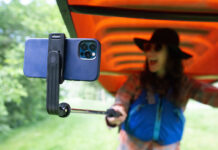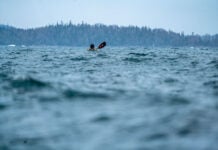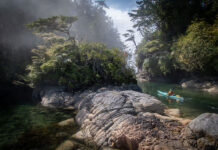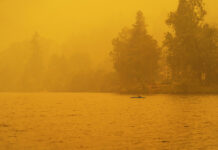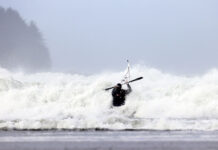I have a favorite cove on a tiny island off the coast of British Columbia. Offshore sea stacks light up pink at sunset, an eagle nests in a nearby tree and a freshwater stream trickles into deep pools.
There’s great surfing when the tide is right. I found it when gunkholing along the coastline’s nooks and crannies. I’ve only ever seen one other person camped there, but I’m worried about bringing my friend, Dave.
Dave’s kit includes a satellite messenger that broadcasts our position. Ostensibly, it’s for calling the Coast Guard or informing family back home if we’re delayed. But it also shares our journey with followers. An email links to a precise location on Google Earth. Armchair adventurers can zoom in and find this particular cove. That thought makes my hackles rise.
Every paddler faces the “how much to tell” dilemma. When I review charts with someone planning a trip to an area I know well I weigh what to share and what to “forget to mention.” I rationalize my withholding as offering them the joy of discovery, but in reality, it’s a kind of wilderness selfishness—territoriality.
I don’t want to see another tent on what I’ve come to consider my spot. We all fear that our places of wild solitude will become like Yogi Berra’s favorite restaurant: “Nobody goes there anymore. It’s too crowded.”
Wanting to keep these special places to ourselves is only a small part of paddlers’ dilemma about wild places. Does bringing more people to wild places save them or destroy them? After a quarter century of kayaking and conservation work, here’s my firm answer: It depends.
I once worked at a wildlife refuge in an industrial district of a big city. Only a few people knew of its existence, which meant only a few people wrote letters or attended hearings about industrial encroachment. First and foremost, people protect what they love and people only love what they know.
I spent three years bringing as many people to that refuge as I could find. Did I worry that we’d spoil the solitude or disturb the wildlife? Absolutely. But those concerns paled in comparison to other threats. And when those threats reared their heads a few years later, there was a community of people to speak up.
Now parking is tight at that kayak launch on weekends, but that’s a price I’ll pay. Each of those paddlers is a potential steward, advocate, and voter. There’s no longer any question that the place should be preserved. The battles the refuge fights today are against the slow creep of invasive species and the erosion of restoration budgets.
Since 1963, we’ve known what happens when we people don’t know a place. That was the year Eliot Porter published The Place No One Knew, a haunting photographic elegy for Utah’s Glen Canyon, drowned beneath the Glen Canyon Dam. With few visitors and lacking the fame of the Grand Canyon, Glen Canyon was too easy to lose.
When it comes to being loved to death, some wild places protect themselves. When Dave Getchell Sr. was creating the Maine Island Trail, he rebutted concern about crowds. “For those concerned that an island trail will bring the Great American Public swarming offshore, no such thing is apt to occur.
Small offshore islands place strong demands on their users, both mentally and physically. Those looking for entertainment and conviviality will find little to suit them on a half acre of rocks, trees, and grass surrounded by an indifferent sea,” he wrote in Small Boat Journal in 1987.
The sea is a strong guardian indeed. I could advertise my favorite kayaking spots on the Oregon coast on billboards, and few would ever get there. The surf, fog, wind and sheer effort will keep all but the most skilled away.
However, many places aren’t so rugged or remote. Tents lined fly-to-vestibule at Kaikash Creek in the Johnstone Strait resemble the subdivisions we’re trying to escape rather than the wilderness we’re trying to retreat into. If it’s beautiful and accessible, the Great American Public will find it.

| Photo: Freya Fennwood
So, when kayakers ask me for the inside scoop on a place, I have a two-pronged strategy. If the area is already protected from major threats and needs long-term watchfulness, I may keep my secret spots under wraps. The newcomers will have a great time without my insider info, or they’ll discover those special spots themselves.
When the location lacks permanent protection or is facing a major threat, I’ll tell them everything. I want them to get the most jaw-dropping views and camp at the most amazing sites.
I want them to take photos that go viral and tell everyone they meet about how amazing a place it is. I want them to fall head over heels in love.
In my back forty, the same answer applies. The Lower Columbia River Water Trail, 140 miles from the Columbia River Gorge to the sea, poses tough questions. How to draw people to the river so they care about it? How many kayakers can the islands hold before they become a mess? How to avoid disturbing rare species?
Fortunately, the Columbia’s wind and current will keep the Great American Public from swarming. Yet, the river still faces threats, like trains loaded with oil and depleted salmon runs. So, I share the best spots right away. I want everyone to fall in love.
Neil Schulman has been paddling and doing conservation work since the Toronto Blue Jays last won the World Series. He is a regular columnist in Adventure Kayak magazine and writes from Portland, Oregon.
Head over heels. Feature Photo: Freya Fennwood



